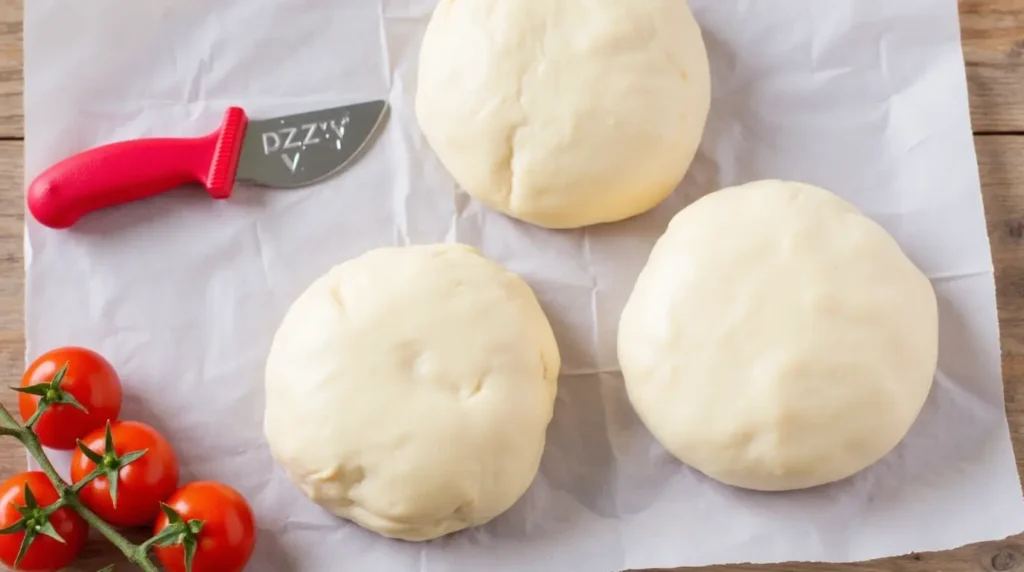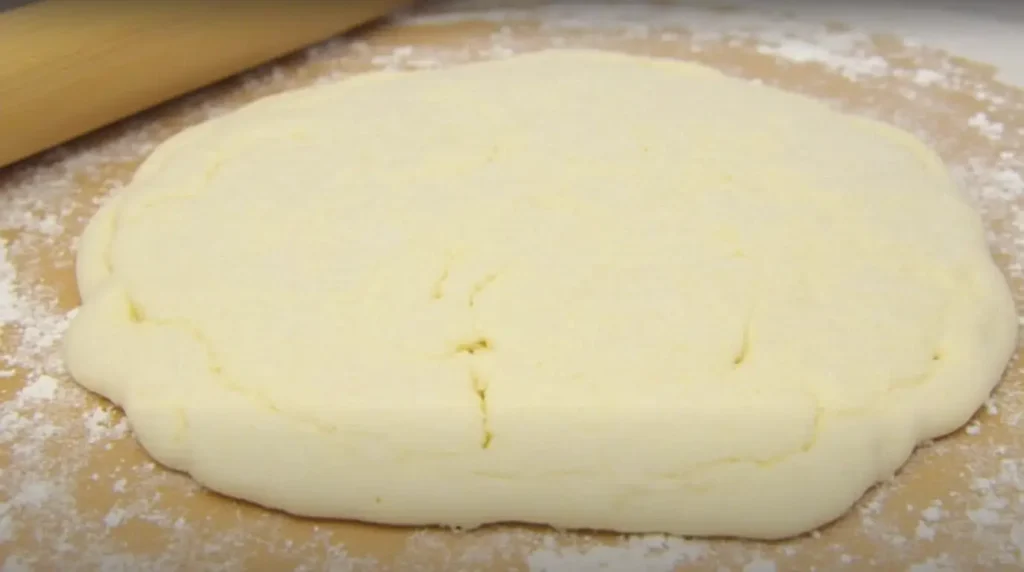A professional pizza dough recipe needs just 6 basic ingredients. Many people think restaurant-style pizza dough requires complex techniques or special equipment. We found that there was a much simpler way to make it than most people imagine.
Homemade pizza dough tastes better and has superior texture compared to frozen options. You can create versatile dough that works perfectly for different pizza styles. The choice of flour matters – bread flour creates a crispy crust, while all-purpose flour gives you a chewier texture. The dough stays fresh in the refrigerator for up to 2 days. You can even freeze it for up to 3 months, which makes it perfect for busy home cooks.

In this piece, you’ll learn the professional secrets to create perfect pizza dough. We’ll cover everything from choosing the right ingredients to advanced techniques that will raise your homemade pizzas to restaurant quality.
Table of Contents
The Professional Chef’s Essential Ingredients
Three key ingredients make all the difference when you want to create professional-quality pizza dough. Let’s look at these game-changing components that separate average pizzas from exceptional ones.
Why bread flour is the secret weapon
Bread flour is the life-blood of superior pizza dough because of its higher protein content. With 12-14% protein content, bread flour builds a stronger gluten network that gives your dough exceptional elasticity and chewiness. This flour type absorbs more water effectively. The result is a perfectly balanced dough structure. Bread flour creates a distinctive flavor and texture that makes it better than all-purpose alternatives.
The truth about yeast selection
Professional pizza makers know that yeast selection substantially affects both fermentation and flavor development. These are the main types of yeast and their unique characteristics:
- Active dry yeast: Requires activation in warm water and provides consistent fermentation
- Instant yeast: Can be added directly to flour and offers faster action
- Fresh yeast: Needs water activation but delivers subtle yet superior flavor
- Sourdough starter: Creates distinctive taste through natural fermentation
Your water temperature should stay between 100-110°F to activate the yeast properly without killing it. Yeast works best in slightly acidic conditions, with a pH lower than 7.
The role of mineral content in water

Water’s mineral content deeply affects dough quality. Water hardness between 100-150 parts per million works best for dough preparation. The calcium and magnesium ions in water interact with wheat proteins to strengthen the dough structure. Dough becomes overly tough and fermentation slows down when water is too hard (over 200ppm).
The ideal water should maintain a pH slightly lower than 7. Many pizzerias solve water quality issues by letting chlorinated water sit overnight or using filtered options. The right mineral balance helps feed the yeast and supports proper fermentation. This creates that perfect dough structure professionals achieve time after time.
Master Techniques for Perfect Pizza Dough
You need to understand three basic techniques that professional chefs use to become skilled at making pizza dough. These methods will help you make homemade pizza dough with the perfect balance of strength and elasticity.
The windowpane test method
The windowpane test is the gold standard to check dough development. This simple technique tells you if your dough has enough gluten to make that perfect pizza crust. You should take a small piece of dough, about the size of a marble. The dough needs gentle stretching between your fingers until you can see light through it without breaking. Your properly developed dough should stretch paper-thin without tearing and show the webby network of gluten.
Professional kneading secrets

Professional chefs know that good kneading forms the foundations of exceptional pizza dough. The dough’s transformation matters more than strict time limits. It takes just 5 minutes to knead correctly – much shorter than most people think. A 30-minute rest period before kneading (known as autolyze) makes the process work by a lot better.
The dough becomes smoother and less sticky as you knead it. Your kneading creates strength in the gluten strands that line up and connect together. This network makes the dough smoother and helps it rise better.
Temperature control techniques
Temperature management is a vital part of getting consistent results. The ideal dough temperature should range between 70-75°F when mixing by hand. Professional bakers aim for temperatures between 75-80°F with machine mixing, unless they have poor refrigeration.
The dough temperature should stay between 22-26°C (71.6-78.8°F) for optimal fermentation. We focused on three factors that affect the final dough temperature: flour temperature, room temperature, and the heat from mixing. Water temperature needs precise calculation by professional bakers to hit their target dough temperature, since water is the only element they can control easily.
Stand mixer users need to pay extra attention to temperature control. The mixers add a lot of heat to the dough during kneading. Professional bakers often keep their flour refrigerated or use iced water to balance this heat transfer.
Hidden Tips for Dough Development
Professional bakers have become skilled at making exceptional pizza dough through precise techniques refined over many years. Let’s look at these significant methods that lift ordinary dough into something special.
The cold fermentation advantage
Cold fermentation is the life-blood of professional pizza making. We stored dough at refrigeration temperatures between 60-65°F. The magic unfolds over time – you’ll want at least 24 hours, but 3-5 days gives the best results. The dough changes remarkably during this period and develops complex flavors while improving its structure.
Slower, colder fermentation creates carbon dioxide at a steady pace. This gives enough time to develop flavor. The process strengthens the gluten network, which helps you stretch the dough without tearing. The dough should rest at room temperature for an hour before you use it.
Proper dough hydration ratios
Professional dough making depends on understanding hydration percentages. Most pizza styles work best with these hydration ranges:

- Neapolitan-style: 60-70% hydration
- Traditional pizza: 60-75% hydration
- High-hydration styles: 65% and above
Hydration levels affect how fast the dough ferments and its characteristics. You’ll get a stretchier, stickier dough with higher hydration. Doughs made for cold fermentation usually need higher hydration percentages to help develop deeper flavors slowly.
Timing the bulk fermentation
The time between kneading and shaping is called bulk fermentation. Professional bakers suggest an 8-hour total fermentation at room temperature (25°C/77°F), split into two phases. The original bulk phase takes about 2 hours, followed by 6 hours of proofing after shaping.
This process is vital because it lets the dough mature without relaxing the gluten network completely. The dough develops and keeps air bubbles during bulk fermentation. These bubbles ended up creating that desired spongy outer crust. Temperature and flour strength change these timings by a lot.
Professional bakers watch the vertical growth carefully in tight containers when making larger quantities of dough. They want to see 30-40% growth for traditional round pizzas. This careful approach will give a consistent result and that airy texture that makes professional pizzas stand out.
Advanced Shaping Methods
Professional pizza makers stand apart from amateurs through their dough shaping skills. These advanced techniques turn simple dough into exceptional pizza foundations.
Hand-stretching vs. rolling techniques
Hand-stretching and rolling create distinctly different pizza styles. The original hand-stretching method preserves gas pockets from fermentation and produces a lighter, airier crust. Rolling pushes gas forward and breaks larger bubbles into smaller ones. This ended up forcing most gas out of the dough completely.
Hand-stretching remains the preferred method for Neapolitan and New York-style pizzas. This technique helps the dough keep irregular air pockets that create distinctive artisanal texture. Rolling works better for thin-crust and deep-dish styles where consistency matters more than texture.
Creating the perfect crust edge
Pizza professionals shape the edge before working on the full dough. They press their fingers into the dough about an inch from the edge to create a small trench that defines the future crust. This method will give a proper gas distribution and helps form the characteristic raised edge.
Proper dough handling leads to an impressive crust. You should avoid pressing over the dough’s end or pinching it against the table – keep a 3/4 inch gap where the crust forms. Gas naturally moves from center to outside, letting the crust hold its bubbles.
Managing dough temperature while shaping

Temperature control is vital during shaping. The best dough temperature ranges between 65-75 degrees Fahrenheit. Dough below 65 degrees fights against stretching because the gluten becomes too tight to work with effectively.
These temperature management guidelines lead to consistent results:
- Let refrigerated dough warm for 1.5 to 2 hours before shaping
- Keep room temperature between 70-75°F during shaping
- Watch dough temperature to prevent overwarming, which can cause excessive elasticity
The right temperature keeps dough pliable without becoming too soft or sticky. Working with properly tempered dough makes stretching easier and creates more consistent results.
Professional Storage and Aging Secrets
Storage secrets make the difference between average and exceptional pizza dough. Professional pizzerias know that proper storage and aging techniques will give their final product amazing taste and texture.
Optimal fermentation conditions
Temperature control is vital for fermentation. Professional kitchens keep their dough between 3-6°C for cold fermentation. The fermentation process slows down at this temperature, which lets flavors develop without damaging the dough’s structure.
The length of fermentation changes two things: flavor complexity and texture. Most professional pizzerias let their dough ferment for 72 hours in cold storage. Some places stretch this to five days, but the dough starts losing its quality after day four.
Proper dough storage techniques
Professional storage needs careful attention. The quickest way to store dough includes these key elements:
- Airtight containers with proper sealing
- Light coating of oil on dough surface
- Adequate space for dough expansion
- Protection from temperature fluctuations
Container choice can make or break your results. Glass containers work best because they don’t react with the dough and let you see the fermentation process. The container should be almost airtight but not completely sealed to prevent too much pressure buildup.
Dough balls that weigh 16 ounces or less need cross-stacking for at least two hours. Balls between 17-22 ounces need 2.5 hours. This technique helps the dough cool evenly and spreads moisture throughout.
When to use aged dough
The right timing for aged dough use affects pizza quality a lot. Flavor develops along a timeline – dough aged 3-5 days gets complex flavors and better texture. The dough changes during this time as enzymes improve its stretchiness and flavor profile.
Each stage of aging creates different characteristics. Two-day-old dough works well, while three-day-old dough tastes best. Day four brings the most complex flavors, but the dough might start getting weaker.
Professional bakers look for specific signs to know when aged dough is ready. Small bubbles and a nice sourdough smell show good fermentation. A strong alcohol smell means the dough is past its prime.
The aged dough should sit at room temperature for 1-2 hours before use. This final step helps the dough reach the right temperature and makes it easier to shape. Even during this short warming time, the dough keeps maturing, which adds to its final texture and flavor.
Conclusion
Professional pizza dough might look intimidating at first. You can achieve excellent results with practice and the right steps. Quality ingredients make all the difference. Bread flour, well-chosen yeast, and mineral-balanced water are the foundations of exceptional pizza dough.
Temperature control is crucial throughout the process. The right temperature will give a consistent result when you mix, ferment, or shape the dough. A cold fermentation of 3-5 days creates complex flavors that make professional pizzas stand out from regular homemade ones.
Your dough transforms from good to great with proper storage and aging. Glass containers, careful temperature monitoring, and patience during aging will reward you with dough that tastes amazing and handles well. These professional techniques may be precise, but they become natural with practice.
Want to start making great pizza? Begin with small batches, test the windowpane method, and slowly increase your fermentation times. You can find more recipes and food ideas in this piece at recipesnutritious.com. Note that great pizza dough comes from understanding the process, not rushing it.
FAQs
Q1. What is the key to achieving professional-quality pizza dough? The key lies in using high-quality ingredients, particularly bread flour, properly selected yeast, and mineral-balanced water. Equally important is maintaining precise temperature control throughout the mixing, fermentation, and shaping processes.
Q2. How long should pizza dough be fermented for optimal flavor? For the best flavor development, professional pizzerias typically use a cold fermentation process lasting 3-5 days. This slow fermentation allows for complex flavors to develop while maintaining the dough’s structure.
Q3. What’s the ideal hydration level for pizza dough? The ideal hydration level varies depending on the pizza style. For Neapolitan-style pizzas, aim for 60-70% hydration. Traditional pizzas work well with 60-75% hydration, while high-hydration styles use 65% or above.
Q4. How can I tell if my pizza dough is properly kneaded? Use the windowpane test: take a small piece of dough and gently stretch it. If it can form a thin, translucent membrane without tearing, your dough is properly kneaded and has developed enough gluten.
Q5. What’s the best way to shape pizza dough? For most artisanal styles like Neapolitan and New York-style pizzas, hand-stretching is preferred. This method preserves the gas pockets formed during fermentation, resulting in a lighter, airier crust. Avoid using a rolling pin, as it can force out the gas and result in a denser crust.


2 thoughts on “The Secret Pizza Dough Recipe That Professional Chefs Don’t Share”
Comments are closed.